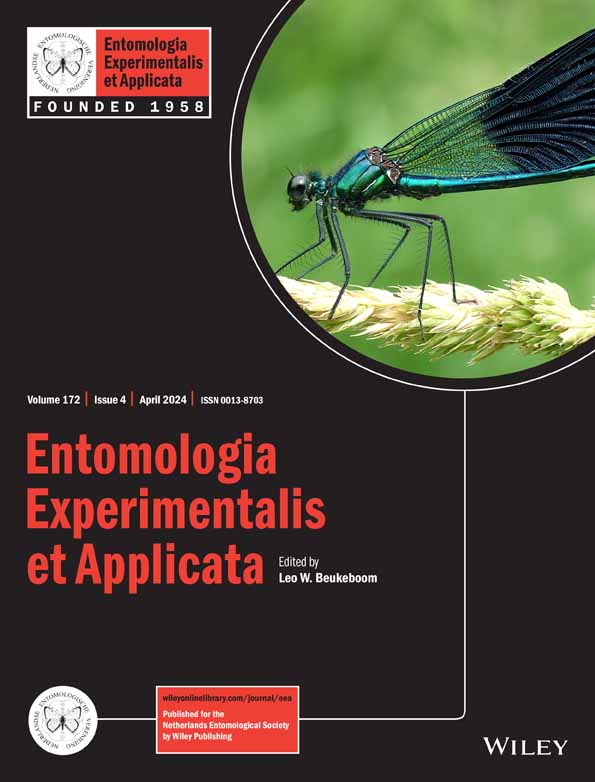Ver ítem
- xmlui.general.dspace_homeCentros Regionales y EEAsCentro Regional Tucumán - Santiago del EsteroEEA FamailláArtículos científicosxmlui.ArtifactBrowser.ItemViewer.trail
- Inicio
- Centros Regionales y EEAs
- Centro Regional Tucumán - Santiago del Estero
- EEA Famaillá
- Artículos científicos
- Ver ítem
Does the Neotropical-native parasitoid Ganaspis pelleranoi successfully attack the worldwide invasive pest Drosophila suzukii?
Resumen
The Asian Drosophila suzukii (Matsumura) (Diptera: Drosophilidae) is a harmful invasive pest widespread throughout Argentinian fruit-producing regions. It coexists with both pests, the sub-Saharan African Ceratitis capitata (Wiedemann) and the Neotropical-native Anastrepha fraterculus (Wiedemann) (both Diptera: Tephritidae), in northwestern Argentina. The Neotropical-native parasitoid Ganaspis pelleranoi (Brèthes) (Hymenoptera: Figitidae) is frequently
[ver mas...]
The Asian Drosophila suzukii (Matsumura) (Diptera: Drosophilidae) is a harmful invasive pest widespread throughout Argentinian fruit-producing regions. It coexists with both pests, the sub-Saharan African Ceratitis capitata (Wiedemann) and the Neotropical-native Anastrepha fraterculus (Wiedemann) (both Diptera: Tephritidae), in northwestern Argentina. The Neotropical-native parasitoid Ganaspis pelleranoi (Brèthes) (Hymenoptera: Figitidae) is frequently found in non-crop fruit infested by those frugivorous dipterans. The northwestern Argentinian region is known for producing and exporting berries and citrus, which are affected by those pests. Thus, eco-friendly control strategies are under assessment. This study mainly assessed the potential of the G. pelleranoi population lineage from Tucumán (GpTuc) as a D. suzukii biocontrol agent. First, both the host-killing effectiveness and the reproductive success of GpTuc on larvae of D. suzukii, C. capitata, A. fraterculus, and Drosophila melanogaster Meigen were compared in no-choice tests under laboratory conditions. Then, the GpTuc host preference was evaluated in dual-choice tests (D. suzukii vs. C. capitata or A. fraterculus) under laboratory and field conditions. Naive parasitoid females were allowed to forage for 8 h on screen-covered Petri dishes filled with host larvae under laboratory conditions and for 48 h on peaches inoculated with host larvae under field conditions. Host puparia dissections were performed to determine the number and condition of parasitoid eggs, first and second instars, such as alive/dead, without/with melanization process, and proportions of parasitized, superparasitized, and dead puparia. Drosophila suzukii was not a suitable host for the successful development of GpTuc immature stages as they did not overcome the host's immune system. However, GpTuc performed efficiently regarding D. suzukii mortality, but parasitoid specificity was restricted to both tephritid species as only thriving offspring were achieved from them. Interestingly, the effectiveness of GpTuc on D. suzukii increased when it co-occurred with C. capitata instead of A. fraterculus, the preferred host.
[Cerrar]

Autor
Buonocore Biancheri, María Josefina;
Núñez-Campero, Segundo Ricardo;
Suárez, Lorena del Carmen;
Ponssa, Marcos Darío;
Kirschbaum, Daniel Santiago;
Garcia, Flávio Roberto Mello;
Ovruski Alderete, Sergio Marcelo;
Fuente
Entomologia Experimentalis et Applicata : 1-14. (First published: 11 March 2024)
Fecha
2024-03
Editorial
Wiley
ISSN
0013-8703
1570-7458
1570-7458
Formato
pdf
Tipo de documento
artículo
Palabras Claves
Derechos de acceso
Restringido
 Excepto donde se diga explicitamente, este item se publica bajo la siguiente descripción: Creative Commons Attribution-NonCommercial-ShareAlike 2.5 Unported (CC BY-NC-SA 2.5)
Excepto donde se diga explicitamente, este item se publica bajo la siguiente descripción: Creative Commons Attribution-NonCommercial-ShareAlike 2.5 Unported (CC BY-NC-SA 2.5)


